Category: NMEA 2000, 0183 & Signal K
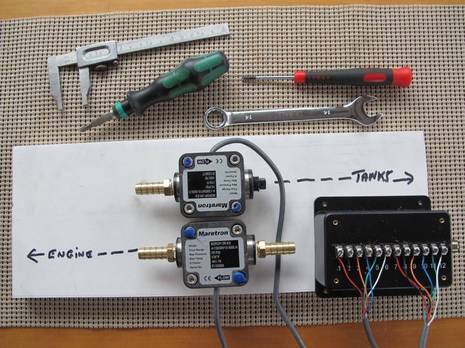 When I first wrote about Maretron’s FFM100 fuel flow monitor, I was enthused about both its advanced sensor technology and the possibilities of a system designed from the ground up for NMEA 2000. Now that I’ve installed the system on Gizmo and tested it a bit underway (before the weather closed in), I’m even more impressed. But I have also learned how difficult it can be to accurately measure how much fuel a diesel actually uses in real time…
When I first wrote about Maretron’s FFM100 fuel flow monitor, I was enthused about both its advanced sensor technology and the possibilities of a system designed from the ground up for NMEA 2000. Now that I’ve installed the system on Gizmo and tested it a bit underway (before the weather closed in), I’m even more impressed. But I have also learned how difficult it can be to accurately measure how much fuel a diesel actually uses in real time…
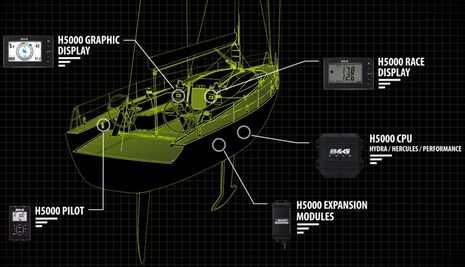 At the METS 2013 show in Amsterdam last month B&G unveiled their new H5000 range of sailing instruments and auto pilots. Unlike the Triton range which is meant for recreational and club racers the H5000 series is designed for high end cruisers and all levels of racers (from club to round-the-world), and replaces the H3000 series. B&G’s racing reputation stems from the capability of their systems to make corrections to the raw sensor values and deduce derived values at high rates. Cruising systems do basic smoothing of raw sensor values (wind, boat speed) and some computations (remember the Panbo discussion on calculating true wind?) but nothing else. The H5000 range can do much, much more. For instance all systems compensate the wind speed for heel and trim angle, there are advanced MOB features and the autopilots have special gust and high-wind response modes.
At the METS 2013 show in Amsterdam last month B&G unveiled their new H5000 range of sailing instruments and auto pilots. Unlike the Triton range which is meant for recreational and club racers the H5000 series is designed for high end cruisers and all levels of racers (from club to round-the-world), and replaces the H3000 series. B&G’s racing reputation stems from the capability of their systems to make corrections to the raw sensor values and deduce derived values at high rates. Cruising systems do basic smoothing of raw sensor values (wind, boat speed) and some computations (remember the Panbo discussion on calculating true wind?) but nothing else. The H5000 range can do much, much more. For instance all systems compensate the wind speed for heel and trim angle, there are advanced MOB features and the autopilots have special gust and high-wind response modes.
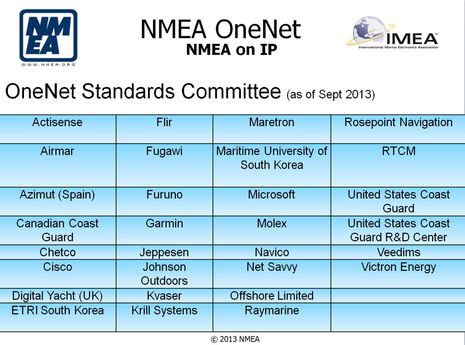 OneNet is the NMEA’s ongoing effort to create a subset of Ethernet and Internet Protocol (IP) standards for marine electronics. It won’t be fully released for two more years, but I liked what I heard (and could understand) in a September seminar delivered by NMEA Technical Director Steve Spitzer. When I first wrote about OneNet, for instance, some skeptical commenters could only envision it as a way for the major manufacturers to keep small developers out and profits up. But that seems paranoid when you consider the wide variety of organizations who are volunteering time and expertise to create OneNet…
OneNet is the NMEA’s ongoing effort to create a subset of Ethernet and Internet Protocol (IP) standards for marine electronics. It won’t be fully released for two more years, but I liked what I heard (and could understand) in a September seminar delivered by NMEA Technical Director Steve Spitzer. When I first wrote about OneNet, for instance, some skeptical commenters could only envision it as a way for the major manufacturers to keep small developers out and profits up. But that seems paranoid when you consider the wide variety of organizations who are volunteering time and expertise to create OneNet…
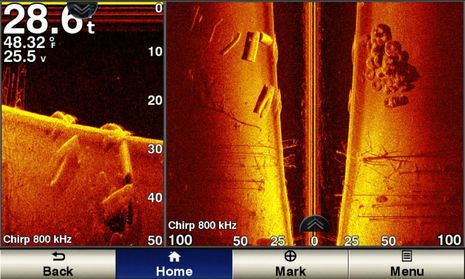 Garmin is purportedly announcing nearly fifty 2014 marine products today! A lot are related to the company’s new ability to offer the high resolution down and side scanning that’s become so popular with freshwater and near coastal fishermen (and curious gunkholers like myself). Soon the relatively easy-to-understand (and fit-on-a-small-screen) down view will be availiable in new echo dv fishfinders and echoMAP dv fishfinder/GPS combos that will then better compete against similar products from Lowrance, Humminbird, and Raymarine. Moving up the cost curve you’ll find CHIRP-assisted DownVü and SideVü, which look wicked sharp in the screenshot above (imaging what’s likely the remains of a bridge in a man-made lake)…
Garmin is purportedly announcing nearly fifty 2014 marine products today! A lot are related to the company’s new ability to offer the high resolution down and side scanning that’s become so popular with freshwater and near coastal fishermen (and curious gunkholers like myself). Soon the relatively easy-to-understand (and fit-on-a-small-screen) down view will be availiable in new echo dv fishfinders and echoMAP dv fishfinder/GPS combos that will then better compete against similar products from Lowrance, Humminbird, and Raymarine. Moving up the cost curve you’ll find CHIRP-assisted DownVü and SideVü, which look wicked sharp in the screenshot above (imaging what’s likely the remains of a bridge in a man-made lake)…
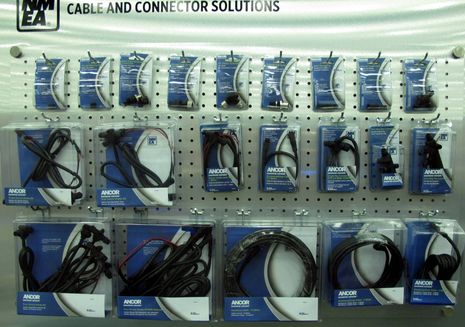 Perhaps coming soon to a marine electronics store near you (though not yet online) is a fairly complete line of NMEA 2000 cables and connectors under the well-known Ancor brand. I particularly like how the kits and explanatory packaging will encourage consumers to set up their own small networks. The 2- and 5-meter cables, for instance, are sold as Backbone/Drop Cables while the 10-Meter is simply a Backbone Cable (because a spur shouldn’t exceed 5 meters). I saw the preview Ancor line above at IBEX but learned more about it in a special Soundings Trade-Only advertorial publication designed for next week’s METS show…
Perhaps coming soon to a marine electronics store near you (though not yet online) is a fairly complete line of NMEA 2000 cables and connectors under the well-known Ancor brand. I particularly like how the kits and explanatory packaging will encourage consumers to set up their own small networks. The 2- and 5-meter cables, for instance, are sold as Backbone/Drop Cables while the 10-Meter is simply a Backbone Cable (because a spur shouldn’t exceed 5 meters). I saw the preview Ancor line above at IBEX but learned more about it in a special Soundings Trade-Only advertorial publication designed for next week’s METS show…
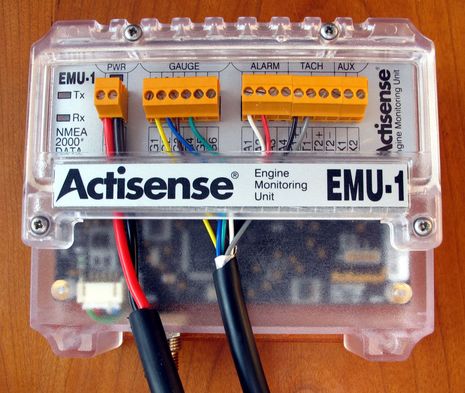 It’s great to test a device that promises to do something new and desirable for the good vessel Gizmo and find out that it installs fairly easily and works quite well. That Actisense EMU-1 is now converting the analog gauge data from the boat’s 14-year-old Volvo Penta diesel into NMEA 2000 messages that can displayed in multiple ways on most any MFD or instrument screen on board, and can also be custom alarmed and logged. I’m going to be better informed about my engine’s health and I’m going to gain some helm panel real estate for better uses than dumb analog guages…
It’s great to test a device that promises to do something new and desirable for the good vessel Gizmo and find out that it installs fairly easily and works quite well. That Actisense EMU-1 is now converting the analog gauge data from the boat’s 14-year-old Volvo Penta diesel into NMEA 2000 messages that can displayed in multiple ways on most any MFD or instrument screen on board, and can also be custom alarmed and logged. I’m going to be better informed about my engine’s health and I’m going to gain some helm panel real estate for better uses than dumb analog guages…
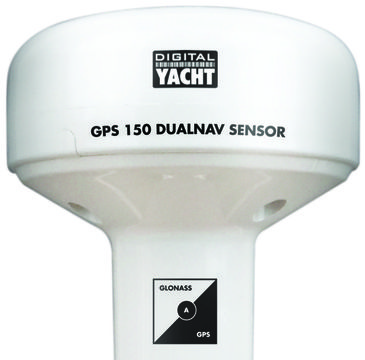 I’ll write soon with NMEA Conference details of the futuristic (and unfinished) NMEA OneNet standard, but I also left San Diego with the strong impression that the good old NMEA 0183 standard is still very much alive. One interesting example is the new Digital Yacht GPS 150 DualNav, which earns its last name for its ability to receive more than one set of positioning satellites at once — already active GPS and GLONASS in particular, more coming — and to then deliver more accurate L/L, COG & SOG than can be gleaned from just one GNSS system.
I’ll write soon with NMEA Conference details of the futuristic (and unfinished) NMEA OneNet standard, but I also left San Diego with the strong impression that the good old NMEA 0183 standard is still very much alive. One interesting example is the new Digital Yacht GPS 150 DualNav, which earns its last name for its ability to receive more than one set of positioning satellites at once — already active GPS and GLONASS in particular, more coming — and to then deliver more accurate L/L, COG & SOG than can be gleaned from just one GNSS system.
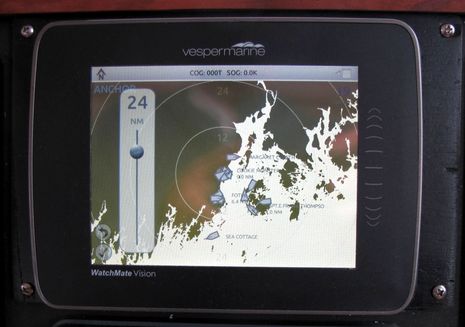 I ended my entry about Vesper Marine’s excellent AIS collision avoidance software with tentative enthusiasm about the company’s next generation WatchMate Vision transponder. Well, a test unit has been installed on Gizmo’s dash since mid-July and, frankly, it’s spectacular. While it certainly offers the AIS target filtering and alerting genius previously discussed, now these talented developers have put maximum AIS utility into a 5.7-inch touchscreen while also creating what could the central WiFi link between a boat’s fixed sensors and a boater’s mobile apps…
I ended my entry about Vesper Marine’s excellent AIS collision avoidance software with tentative enthusiasm about the company’s next generation WatchMate Vision transponder. Well, a test unit has been installed on Gizmo’s dash since mid-July and, frankly, it’s spectacular. While it certainly offers the AIS target filtering and alerting genius previously discussed, now these talented developers have put maximum AIS utility into a 5.7-inch touchscreen while also creating what could the central WiFi link between a boat’s fixed sensors and a boater’s mobile apps…
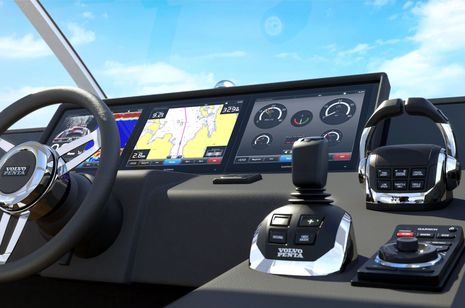 When I wrote about seeing the new Garmin 8000 Glass Helm series in Miami, several knowledgeable readers commented about how it would be used as part of a complete Volvo Penta engine/helm package. They were right. Garmin announced the VP Glass Cockpit yesterday and it’s already up in detail at Volvo Penta. The main features seem to be great nav screen integration with joystick, trim, and autopilot controls plus a single vendor for all, but is this also what we’re going to see from all the glass bridge/helm/cockpit systems?
When I wrote about seeing the new Garmin 8000 Glass Helm series in Miami, several knowledgeable readers commented about how it would be used as part of a complete Volvo Penta engine/helm package. They were right. Garmin announced the VP Glass Cockpit yesterday and it’s already up in detail at Volvo Penta. The main features seem to be great nav screen integration with joystick, trim, and autopilot controls plus a single vendor for all, but is this also what we’re going to see from all the glass bridge/helm/cockpit systems?

I so appreciated getting to know Dr. Yung Ho Yu — known around the world simply as Dr. Yung — at the Korea Maritime University in Busan, and I think you will too once you realize how much he and his programs are doing to advance marine electronics and improve the standards that make them inter-operable. For starters, take a close look at the NMEA 2000 teaching lab surrounding the good Doctor. The twenty work stations are all gatewayed to an extensive N2K sensor network so that students can experience and even interact with the protocol right down to the bit level as the instructor demonstrates from his work station. I’d like to be wrong, but I doubt that there’s a similarly powerful teaching and research tool anywhere else on the planet…
 When I first wrote about Maretron’s FFM100 fuel flow monitor, I was enthused about both its advanced sensor technology and the possibilities of a system designed from the ground up for NMEA 2000. Now that I’ve installed the system on Gizmo and tested it a bit underway (before the weather closed in), I’m even more impressed. But I have also learned how difficult it can be to accurately measure how much fuel a diesel actually uses in real time…
When I first wrote about Maretron’s FFM100 fuel flow monitor, I was enthused about both its advanced sensor technology and the possibilities of a system designed from the ground up for NMEA 2000. Now that I’ve installed the system on Gizmo and tested it a bit underway (before the weather closed in), I’m even more impressed. But I have also learned how difficult it can be to accurately measure how much fuel a diesel actually uses in real time… 

















